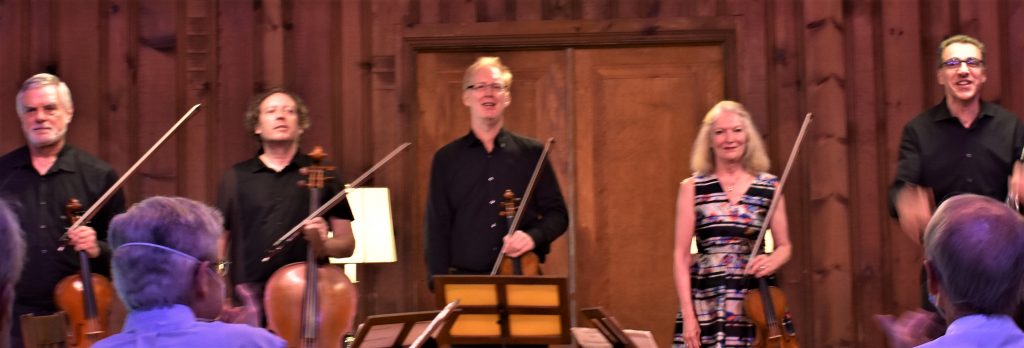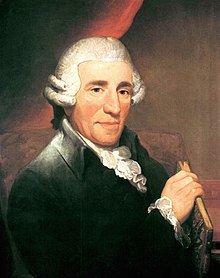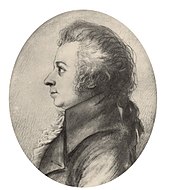
Peter Winograd’s violin delivered authoritative gravity with a touch of severity in the first movement Allegretto of Franz Joseph Haydn’s String Quartet in D Major, Op. 76, no. 5, which, like many of his quartets, explores new ground with vigorous contrasts. Fresh from his tour of London, he returned to Vienna in 1795 with new ideas for his last few quartets (a lifelong obsession). In roughly sonata form, the irregularities are such that the movement appears to question what a sonata is without providing any answers. Or perhaps raising the question: who was this fascinating enigma?
The following extended Largo, perhaps the most famous of the four movements, was dominated in lament by Wolfram Koessel’s eloquent cello as it appears to mourn the death and burial of some important personage; the effect is astonishing in its contrast to the opening movement. Some have called this work the Graveyard Quartet because this Largo has often been played at burials. The melody remains positively haunting, strange, and Otherworldly.

The Menuetto appears to be a memory homage in recollection of a noted ball where the departed personage was the wit of the event as he danced and entranced the partiers with a genial wit that resulted in communal joy and gaiety. Here Laurie Carney on second violin and Daniel Avshalomov on viola played more integral roles in creating this memorable, communal event, and rounded sound.
The Presto finale was so redolent with warmth and gentle lament that there was something wonderfully transcendent about the movement which possessed such charm that one wished the quartet would never end. Here the unity of the playing evoked the feeling that the audience and players could not be more in agreement.
My speculation? This was Haydn’s tribute to Wolfgang Amadeus Mozart who died in 1791 and was summarily buried in a pauper’s grave on a cold December day because his last opera, The Magic Flute, gave political offense to the Austrian Queen.

Dmitri Shostakovich’s String Quartet #8 in C Minor, Op. 110, dedicated to the victims of fascism, is one of my favorites. Written during a visit to East Germany in July 1960 to write a film score for Five Days and Five Nights (about the fire-bombing of Dresden). This harrowing quartet (written as an inspired side-job) was penned within three days; upon completion, Dmitri nearly committed suicide, saying it was farewell autobiography and that he could no longer go on living, fearing that this piece would transport him to a gulag. A friend, Lev Lebedinsky, stole the sleeping pills which Dmitri planned to consume.
The true meaning of the quartet is a lament for the endemic fascism of both Germany, Russia, and its prolific attraction in all nations, and so its resonance contains a contemporary vitality. The work contains a plaintive motif of self-pity since much of the work consists of self-quotation fragments from various compositions. This quartet offers an apocalyptic lament for the graveyard cruelty of humanity, yet its musical lines remain so arresting (as they were deeply influenced by the theme of the movie he was working on).
The opening Largo freights somber suspense. The fury of the Allegro molto may have been inspired by the opening of Haydn’s Op. 76 #5. But here, it is the fury of the senseless, punitive bombing of Dresden, symbolic of the vindictive products of fascism. This quartet is the musical brother of Pablo Picasso’s famous Guernica painting. Yes, this Allegro is shocking and despairing and there is nothing more arresting in the musical canon with its unnerving, despairing dissonance. The Allegretto moves from the particular in the Allegro molto to the universal plight of humankind throughout history.
The next Largo swims in lugubrious resignation amid a claustrophobic ambiance of unending rain (tears?), yet the concluding Largo is akin to a striking red sunset, ambiguous about what the next day will bring, which is a most satisfactory reversal, even in its gesture of impotent vagueness.
The final tune is based upon a popular Russian dirge, which can be translated as “He died in Hard Slavery” or “Tormented by a Lack of Freedom.” The shocked audience demanded three bows. The Eighth Quartet was the first music played at Shostakovich’s funeral on August 14, 1975. In fear of arrest the musicians who played departed immediately.

After intermission, Guest Artist Oskar Espina-Ruiz joined the American String Quartet to perform in Mozart’s Clarinet Quintet in A Major, K. 581 (1789). Written for fellow Mason Anton Stadler, this quintet shows off the instrument in its imposing loudness and hushed softness, its fluid transitions, displaying the clarinet’s mercurial talent as both tragic and comic, a leader and blender, boaster and whsiperer, noble and fraternal, a master of chamber music parlance. Oskar was most remarkable in the subtle, mellow qualities of tone and range.
This playful piece provided an optimistic reversal of the more somber themes of the concert. The concluding five variations and coda display Mozart’s ingenuous ability to entertain even when he does not have much to say. It is rather amusing that the second violin snatches the bass line from the cello at the amusingly prankish conclusion.
Once more the ecstatic audience demanded three bows.

Next Sunday the Cassatt String Quartet will play Mozart and Amy Beach while pianist Ursula Oppens will play selections from Fanny Mendelssohn’s Das Jahr.